Nathan Fillion is one of the rare performers that is universally adored. The actor’s quick humor and boyish charm have garnered him a devoted fan base in both film and television. While most viewers of this video are familiar with Fillion as the dimple-cheeked, wise-cracking, borderline man-child protagonist of Castle, we originally saw him as the handsome captain of the Serenity: Malcolm Reynolds.
Firefly premiered in 2002 to tremendous acclaim, combining elements of science fiction storytelling with the aesthetic characteristics of an Old Western. The plot sounded intriguing: a renegade, war-weary captain leads his crew in a revolt against a cosmic ruler. The terrible aspect is that we never got to see it through to the finish.
Firefly was canceled 11 episodes into its run and has since become a cult favorite. And it’s not only TV shows that get this treatment. Many legendary TV programs have been canceled early over the history of television, and cartoons are no exception.
What may have been fascinating us? Thanks to intense fan support and shifting views in the entertainment business, some famous, unfinished cartoon programs received a suitable finale years after they were originally discontinued.
We’ve all heard of Hey Arnold! and Matt Groening’s breakthrough Futurma cartoon series. There is a slew of others that have yet to be settled. In this video, we present some of the most underappreciated cartoon programmes from the Golden Age of Cartoons, the 1990s, that were canceled far too soon.
Cybersix (1999)
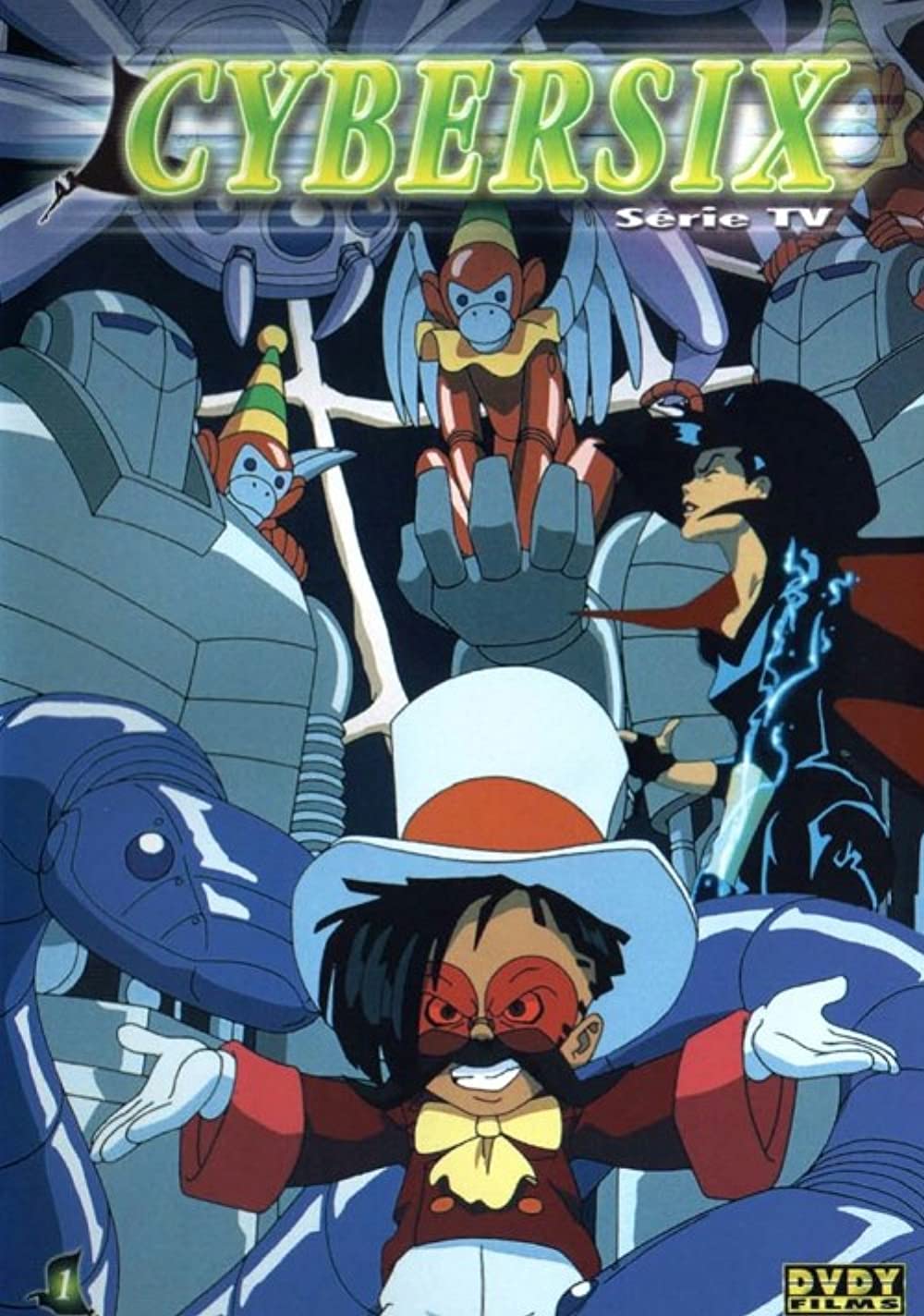
We’re big fans of cultural oddities: items that shouldn’t work together because of their disparate sources of inspiration, but do. You can imagine our excitement when we first saw Cybersix. The anime follows the exploits of the leather-clad, genetically created “Cyber-6,” who is on a journey to overthrow her Maker and is based on an Argentine comic book series of the same name.
After escaping the secret lab where she was made, Cybersix arrives in the city of Meridiana and is hunted by her creator, Dr. von Reichter and his clone-son José. Using her powers, she shape-shifts into the male teacher “Adrian” and uses it as her cover by day, protecting her identity.
She tracks von Reichter and fights his minions at night, alongside her pantherized brother Data-7. Over the course of 13 episodes, we see her fight monsters, confront her past and embrace a possible future with her love interest Lucas. At the end of its short run, we see Dr. von Reichter’s demise, Cybersix’s escape, and José surviving the blast, which ended the series with an uncertain ambiguity.
The distinctive animation of this short-lived cartoon is one of the first things that will captivate you. The 1990s are known as the “Golden Age of Cartoons” for a reason: it was during this decade that the world of Japanese animation was first introduced to broad Western viewers.
TMS Entertainment had already worked on seminal cartoon shows like Spiderman: The Animated Series by this point and Cybersix made full use of their animation prowess. They brought the world of Cybersix to life and filled it with their signature style of animation. Meridiana is a wonderful depiction of what Miyazaki’s work would look like if it were dystopian; grey, run-down, desolate, and yet beautiful in a grim manner.
What we personally loved are the character designs. A blend between the anime-style production and Western cartoon silhouettes, the characters of Cybersix created a sort of disjointed harmony. They didn’t look like they belonged to this world, and that engages you even more, as opposed to putting you off.
Cybersix’s background score is an eclectic mix of cartoonish sound effects and the subsuming soundtrack of a Japanese anime. The Robbi Finkel-composed opening theme is iconic, with Coral Egan’s haunting rendition of “Deep in my Heart” being one of the best themes of all time. Though the story has been modified for a much younger audience, in 13 short episodes, Cybersix will endear itself to you with its stunning visual presence and heart-rending themes of acceptance & emotional turmoil.
TaleSpin (1990)
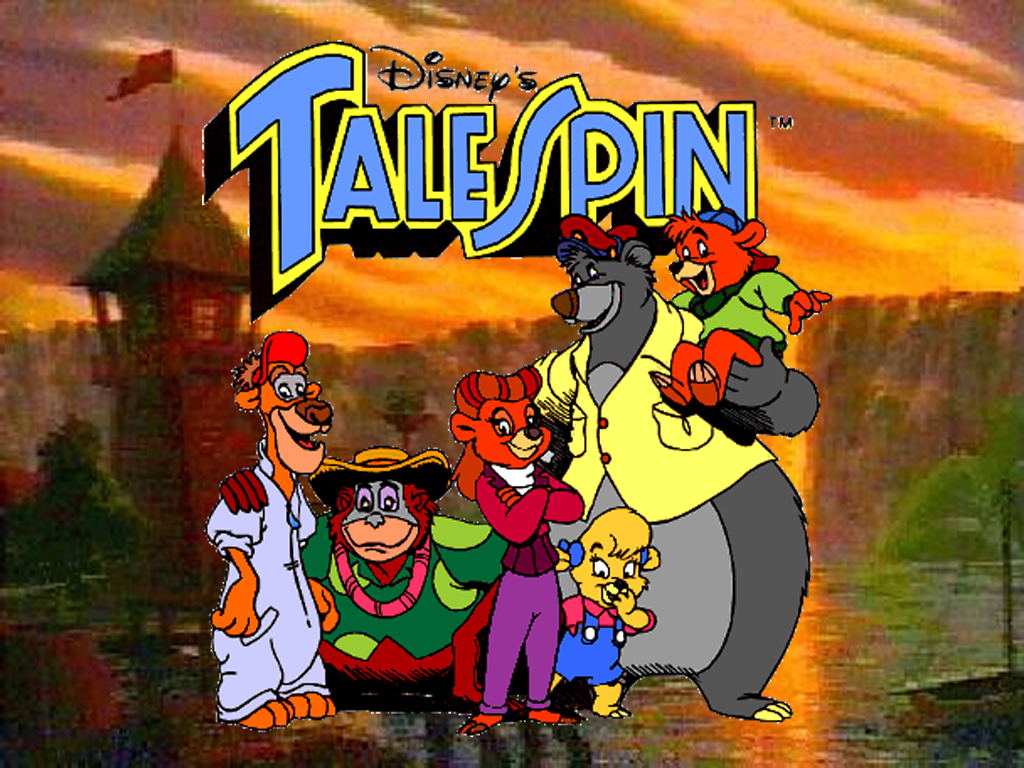
For most of us, Disney represents our youth, and TaleSpin was one of their favorite formative cartoons in 1990. TaleSpin is an anthology-style game loosely based on characters from The Jungle Book. Baloo the Bear, an eccentric bush pilot who lives in Cape Suzette, is the focus of our attention.
He, alongside his partner Kit Cloudkicker and business-owner Rebecca Cunningham, go on several adventures across Cape Suzette. They try to build their company “Higher of Hire” and fend off excesses from the air pirate Don Karnage and Khan Industries, run by the uber-wealthy businessman Shere Khan.
Despite its appearance as a basic children’s cartoon, TaleSpin’s influences are surprisingly sophisticated. The title of the programme is a clear reference to America’s first aviation-themed comic strip, Tailspin Tommy, which also serves as a model for Baloo’s persona. It is also a double entendre that reflects the anthological structure of the show: every episode is named after commonly-used phrases and popular pieces of fiction- visual and literary- which are then incorporated into that episode’s storyline.
For instance, in the episode “A Star is Torn”, Baloo is starstruck by the actress Kitten Kaboodle, and signs on as her stunt pilot. However, Kitten is later revealed to be the episode’s antagonist, having engineered several “accidents” across the set which put Baloo’s life in danger.
Though every episode is unique, the thread that connects each episode is not just the characters, but a sense of moral lessons: Baloo’s countless adventures reflect his inherent selflessness and his gentle nature. Of course the animation itself is oozing with nostalgia. If there’s one thing we envy of Disney, it’s their capacity to breathe life into their stories.
Every frame is teeming with activity, and the various studios attached to the project did a masterful job of emulating that sense of majesty and wonder that is associated with most Disney ventures. As the cherry on top of the cake, veteran voice actor Jim Cummings takes on the role of Don Karnage with such aloof vigor that we personally think it’s amongst his best work as a voice actor to date; and yes, that includes Winnie the Pooh, too!
The Pirates of Dark Water (1991)
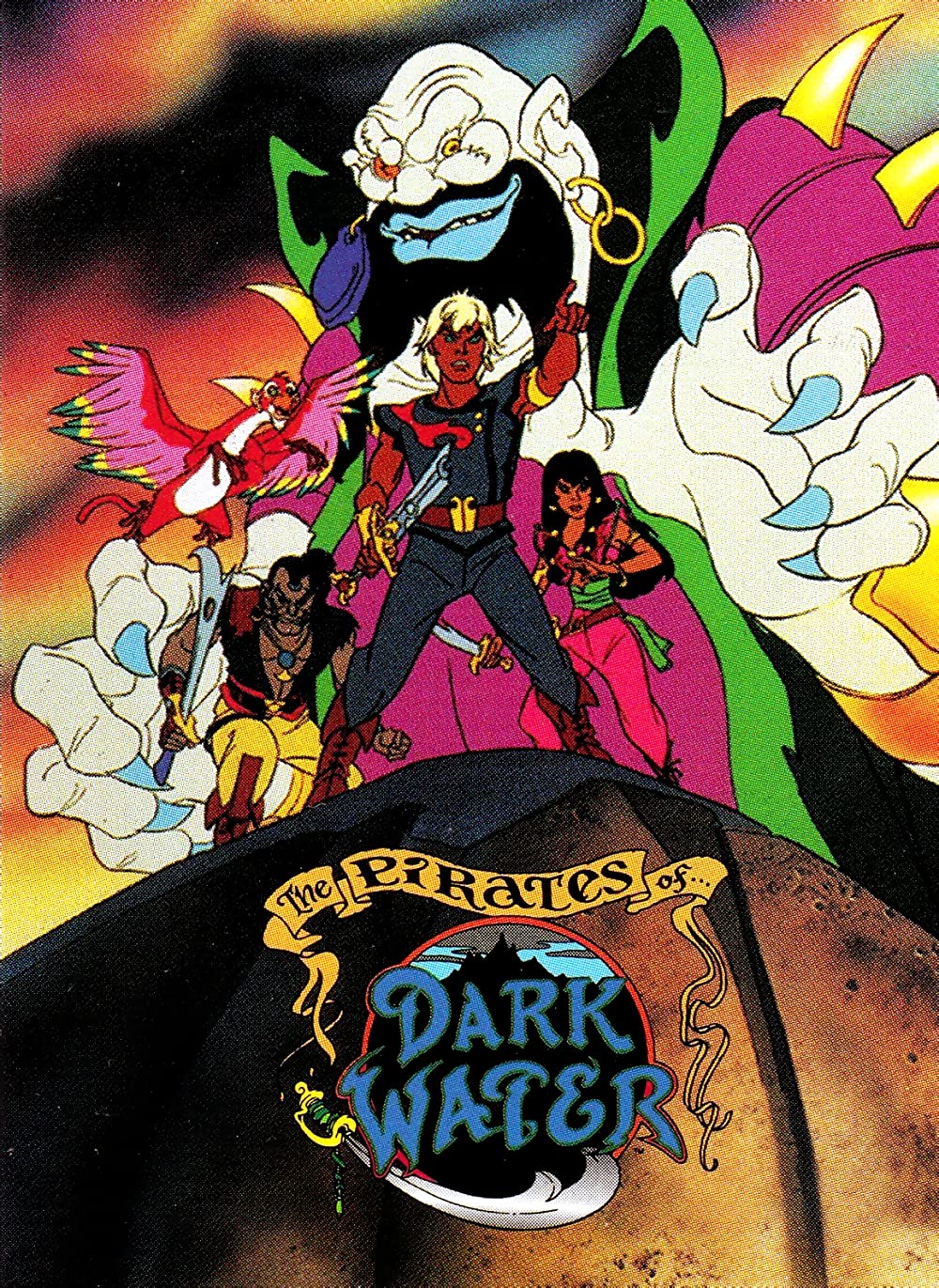
A strange, oil-like fluid known as “Dark Water” is engulfing the planet Mer, threatening to wipe out all life. Ren, a young lighthouse keeper, is thrust into action when it is revealed that he is the son of a long-lost empire’s king.
He must cruise the 20 seas of Mer with his odd crew in search of the Thirteen Treasures of Rule, which can stop Dark Water’s fast invasion and preserve Mer from annihilation. The notorious pirate Bloth searches for the Treasures to fulfill his own agendas. This puts Ren&Bloth’s crews on a collision course; a race against time to gather the treasures and fulfill their purpose.
The Pirates of Dark Water is one of our favorite books for two reasons: its intricate world-building and flawless dialogue. Mer isn’t your average alien planet with simple divisions; it’s full of history and legend. On Mer, there are numerous different kinds of life. Fiddler, Ren’s friend, is a sentient monkey-bird with its own civilization, which is briefly explored as a subplot.
Ren’s other companions have colorful backstories as well: Tula is an necromancer who can control the elements and biological life (sentient and non-sentient), while Ioz is a pirate who becomes Ren’s mentor as the series unfolds. But while these characters and their quest for the treasure is an adventurous watch in itself, the real treat is Bloth: the captain of the Maelstrom and the main villain of the series.
90’s cartoons followed a certain trope with most villains; they were often portrayed as cowards with no inherent sense of aggressiveness. Bloth is a monstrously huge pirate, notorious across all the 20 seas of Mer, who brought down Ren’s father and now aims to become the ruler of Mer. He is portrayed as a man driven by purpose and utterly without mercy. Another thing that makes this series iconic is the casting. At the time of its release, The Pirates of Dark Water boasted an all-star cast of voice actors. Ren was voiced by George Newbern, famous today for his fabled run as DC’s animated Superman.
Bloth’s sadistic and cruel personality was brought to life by Brock Peters, who is well known for his turn as the Sith Lord Darth Vader in the radio drama adaptations of the original Star Wars trilogy and Lucius Fox from Batman: The Animated Series. Though the cost of production for this massive, epic fantasy proved too much for Hannah-Barbera Productions, the 21 episodes that exist are a testament to what could have been.
Street Fighter: The Animated Series (1995)

When Street Fighter II first came out, it was THE thing. As a result, the existence of this series comes as no surprise to us. Street Fighter: The Animated Series drew heavily from the franchise’s previous adaptations. Colonel Guile is the protagonist, while M. Bison is the adversary, in a tale that closely mirrors that of the live-action film.
The Colonel is a part of an undercover operation codenamed Street Fighter and their mission is to stop the evil Bison from going through with his schemes to terrorize & rule America; and by extension the world. Every character from Street Fighter II appears in the series in some capacity.
We now know that anything inspired by a video game is more likely to fail than succeed. However, Street Fighter has a certain allure that we can’t deny. The story’s idea is intriguing: rather than taking the true military approach taken by the film, this series focuses more on gaming.
The medium affords this freedom, of course, but there is something about seeing Chun-Li smash up a tank with her legs in the opening theme that makes us stay glued to our seats. The animation style is the pure embodiment of 90’s American cartoons: sharp lines, exaggerated features, dark colors, the whole nine yards; which is what makes it such a treat to watch!
The introduction of secondary villains in season 2 keeps the narrative fresh. Most of season one is a focused fight against Bison, but season 2 explores subplots with other characters that creates a streamlined and engaging story.
Watching the backstories and plot arcs of characters we have known since our childhood will always bring out our fondness for the franchise. Every minute of this 26-episode show is rife with action, animation and nostalgia; and we’re here for it.
Captain Simian & the Space Monkeys (1996)
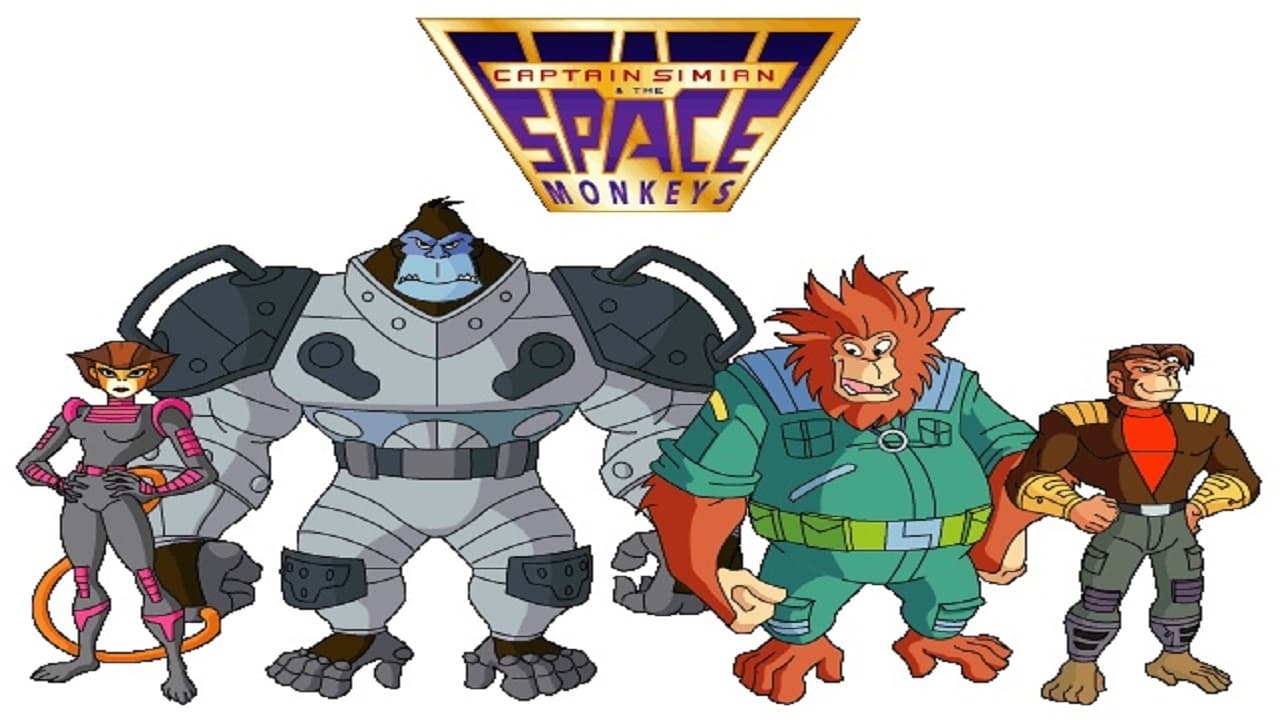
Humans are known to have descended from apes and monkeys. But what if they were the most advanced version of ourselves? This is explored in Captain Simian & the Space Monkeys. NASA took the chimp Charles into orbit as part of its space program in the 1960s.
However, his ship steered off course and encountered an alien species that gave him sentience. Tasked with the duty of thwarting the immortal Lord Nebula’s plans for universal conquest, the rechristened Captain Charles “Chuck” Simian and his group of intelligent Space Monkeys travel across the universe, fighting and adventuring on distant worlds.
Captain Simian & the Space Monkeys is, for all means and purposes, one of the funniest cartoons we’ve come across. The hilarity is evident from the very first episode. We meet the wisecracking tiny spider monkey Spydor, who was caught pickpocketing innocent civilians in a previous episode, when Chuck assembles his gang.
The Space Monkeys’ introduction is hilarious, as we see the indifference of some members and the wariness of others. Spydor seems unbothered, though; he’s just a being of pure mischief. As the series progresses, he forms an enigmatic duo with the simple-minded gorilla Gor.
Think Rocket Raccoon and Groot, except they’re both monkeys and Groot’s vocabulary goes beyond three-four words. The series’ prominent running gag comes from its big-bad himself: Lord Nebula. This cosmic entity is a half-humanoid, half-black hole. Because he exists in this state of limbo, his appearance is, well, gaseous, and so is his digestive tract, if you catch our drift.
Another recurring gag is Splitzy’s impersonations of other celebrities, which ranged from Beavis & Butthead to Arnold Schwarzenegger’s Terminator. Canadian voice-actor and impressionist Maurice LaMarche’s take on Splitzy had us in knots whenever he’d bust out another impression.
This series flips sci-fi tropes on its head with a visceral decisiveness. When the aliens find Chuck and conclude that he must be the most evolved form of human beings in existence, it inverses the evolutionary scale. Throughout the movie, we see a Planet of the Apes-esqueawakening of an intelligent primate species.
So instead of mankind ascending to another sphere of existence, our evolutionary ancestors gain sentience. That alone was enough to pique our interests. The comic timing is a bonus that makes this 26-episode watch even more worthwhile.
SWAT Kats: The Radical Squadron (1993)

We offer you two of the most badass felines on the face of the planet! In 1993, SWAT Kats: The Radical Squadron burst onto the scene. We follow the adventure of Jake and T-Bone, discharged military veterans with a score to settle and a chip on their shoulder, in a universe where anthropomorphic cats govern the planet. Now operating as vigilantes, they fight crime all across Megakat City as the SWAT Kats.
We immediately focus your attention on the activity. Yes, there have been numerous action cartoons, but SWAT Kats stand out because of its explosive animation style. The fast, aggressive pace of this buddy-cop animation is defined by the opening tune, which is memorable in its own right.
While fixing a car at their garage, Jake & T-Bone hear the sound of crime, suit up and fly off in their trusty Turbokat as the guitar swells up in the background. This one-minute intro is all you need to get on the hype train, and it never falls off for 25 episodes. Hannah-Barbera Productions put their full weight behind making SWAT Kats a success, and it shows in the production; crisp, gritty, and captivating.
SWAT Kats’ gallery of villains boasts some of the most iconic bad guys in the history of short-lived cartoons: we have the villainous mutant Dr. Viper, the time-traveling Pastmaster, and the overarching threat of the Dark Kat lurking in the shadows of Megakat City at all times. Jake & T-Bone’s rambunctious, free-spirited personalities brought a light edge to this otherwise tonally-dark series.
Although it was short-lived, thanks to poor toy sales anda bunch of revenue-related factors, SWAT Kats is still fondly remembered by many (including us!) as an integral part of their childhood, and deserves a re-watch if only to watch Jake & T-Bone blow stuff up.
Biker Mice from Mars (1993)
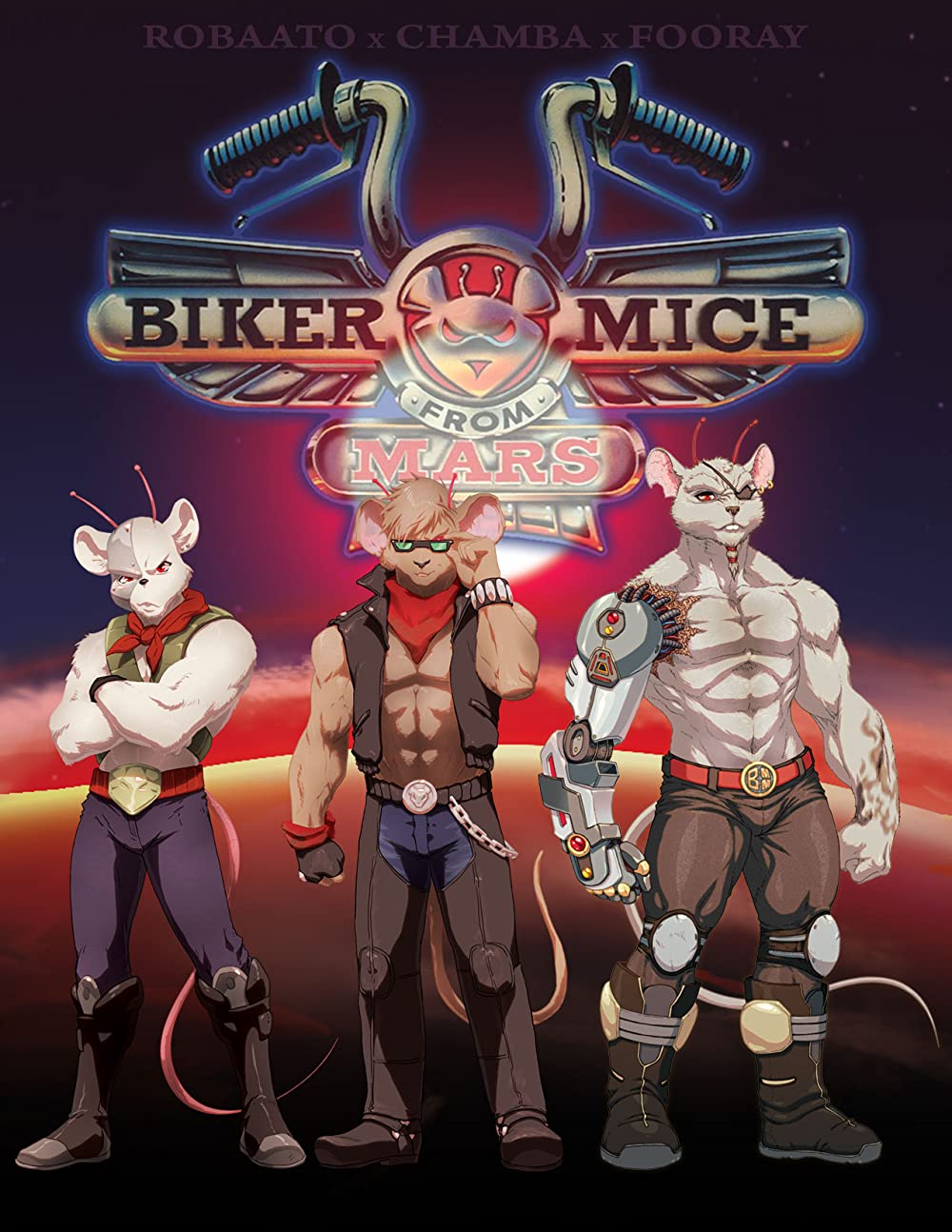
Let’s speak about mice now that we’ve talked about cats. Throttle, Modo, and Vinnie, anthropomorphic mice from Mars, descend on Earth as interplanetary refugees in Biker Mice from Mars. The Plutarkians, an invading extraterrestrial species, have launched an attack on Mars.
These Plutarkians conquer planets, devour its resources, and move on to the next planet to repeat the cycle. Throttle, Modo & Vinnie managed to escape Mars but their spaceship malfunctioned and they landed on Earth.
Allying with Charley, the owner of the Last Chance Garage, they fight against the Plutarkians on Earth, primarily Lawrence Limburger. This show follows an anthological structure for its majority, where the Biker Mice defeat Limburger and/or their minions and their schemes, and save the day.
What drew us to this programme was its dedication to the world it had created: an alien species of mice from Mars that are just as intelligent as humans and also happen to be the world’s most laid-back motorcycle gang. The biker aesthetic is embraced by Biker Mice from Mars.
Every scene with our dynamic trio is scored to blaring hard rock music. Their dialogues are reflective of the conventional understanding of “biker slang”. And last but most importantly, their character designs are just downright awesome. Another thing that drew our attention to the series was its premise.
Now, alien predators and invaders aren’t new, but what stood out at us was how very “human” the Plutarkians were. Their home planet was dying, stripped of its natural resources. The reason the Plutarkians took resources from other planets was so they could save their own. Biker Mice from Mars is, in many ways, an allegory for human indulgence. Lawrence Limburger is a grotesquely huge person, in both human and alien form.
He’s referred to as the “Supreme Cheesiness”, which can just be a play on the mouse theme of the show, but can also indicate luxurious indulgence. In him, and the Plutarkians in general, greed is personified.
It can be seen as a foreshadowing of what our own indulgence will lead to, but maybe we’re getting ahead of ourselves. The last three episodes of Biker Mice from Mars explore the origins of our dynamic trio, and we think it’s poetic that this bawdy tale of Biker Mice from the planet Mars ends with a tale of the beginning.
Cadillacs & Dinosaurs (1993)
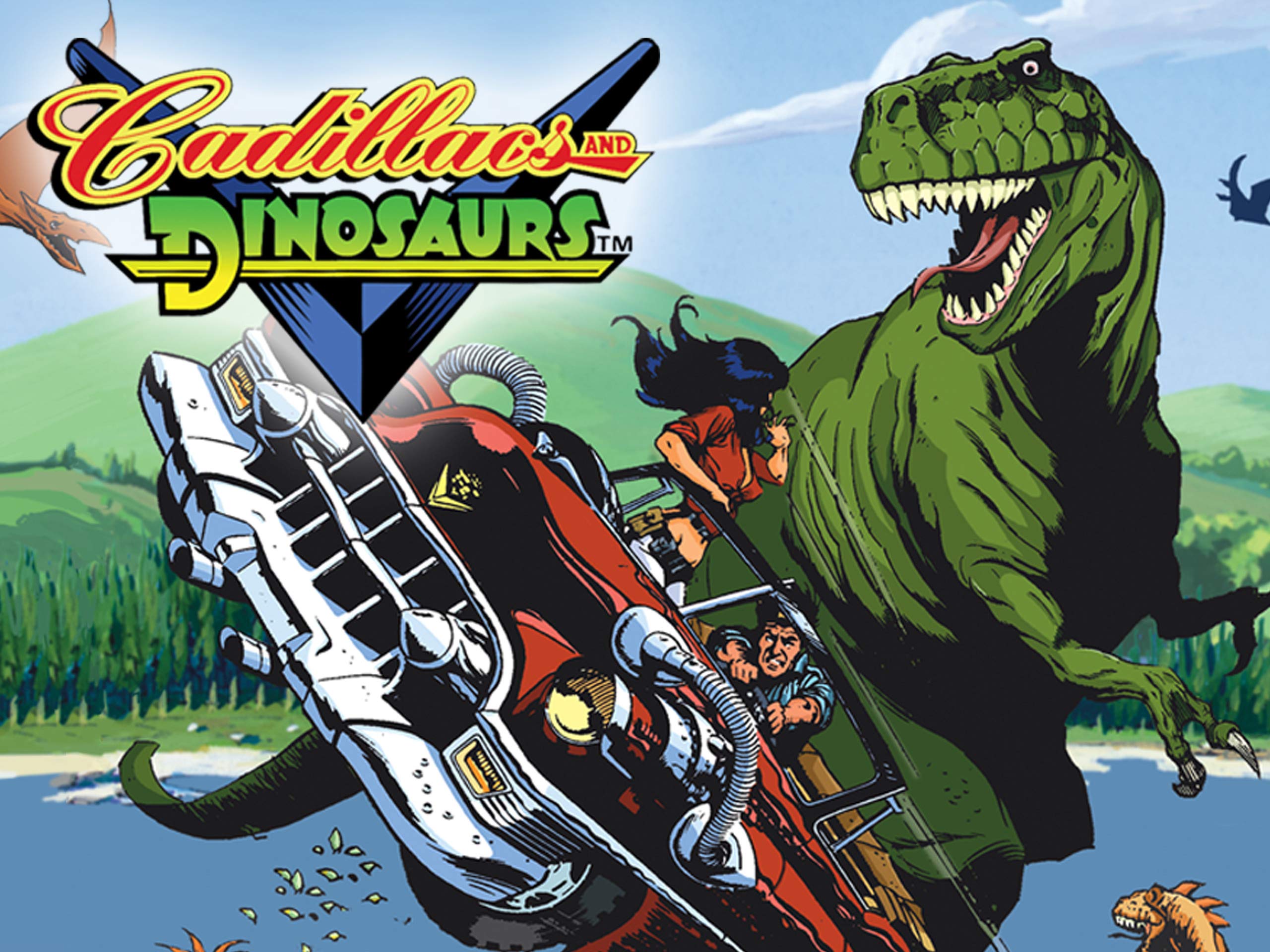
This is a spectacle that delivers exactly what it promises: Cadillacs and real-life, 10-foot-tall, sprinting Dinosaurs. Jack Tenrec is a member of the “Mechanics,” an ecological liberation movement fighting to protect nature from the devastation of a post-apocalyptic Earth.
The only problem is; this includes Dinosaurs. Global warming and extreme climate change forced mankind to live underground for 500 years. When humanity re-emerged, dozens of extinct species had miraculously come back to life, including the Dinosaurs.
Now, Jack and his crew must figure out a way to peacefully co-exist with the dinosaurs while stopping a gang of deadly poachers, led by Hammer Terhune and backed by Governor Wilhelmina. Over the course of 13 episodes, we see the Mechanics take on Hammer’s gang and Wilhelmina’s shrewd political maneuvers while trying to keep the dinosaurs safe from harm.
We prefer to think of this series as a boosted-up version of Jurassic Park. Of course, there are distinctions! The dinosaurs in the movie were created artificially, but the ones in this series arose spontaneously. Jurassic Park’s dinosaurs were confined to Isla Nublar, whilst Cadillacs & Dinosaurs depicts them as a natural part of the ecosystem. That’s something we really appreciated in the series.
Jack Tenrec isn’t your run-of-the-mill anti-government vigilante; he is an ecological freedom fighter who understands the balance of life. In his very first appearance, we see him struggle with the fact that his understanding of the cycle of life isn’t universal. He encounters a group of people he’d helped settle putting out a fire caused by a Shivet he let loose. It causes a moral crisis of sorts: on the one hand, he promised these people they’d be safe from danger and his word had come undone. But on the other hand, the Shivet was a living creature whose presence was essential to the ecological cycle.
So we see Jack take the third route and help both the refugees and the dinosaur while tackling the real culprit: poachers. This is a recurring theme where we see Jack actually help the dinosaurs survive; he has a pet Allosaurus, for heaven’s sake! The nuanced portrayal of environmentalism and a post-apocalyptic Earth sealed the deal for us.
From the use of localized names for dinosaurs down to the designs of the various characters and their socio-political backgrounds, Cadillacs & Dinosaurs has a sense of authenticity which is rare in such cartoons.
The animation itself is gorgeous: from Jack’s beloved Cadillacs to the vibrant scales of the Shivet, every frame in this show seems alive. So if you’ve asked yourself what would happen if dinosaurs came back to life, we might have just given you your answer.
Extreme Ghostbusters (1997)
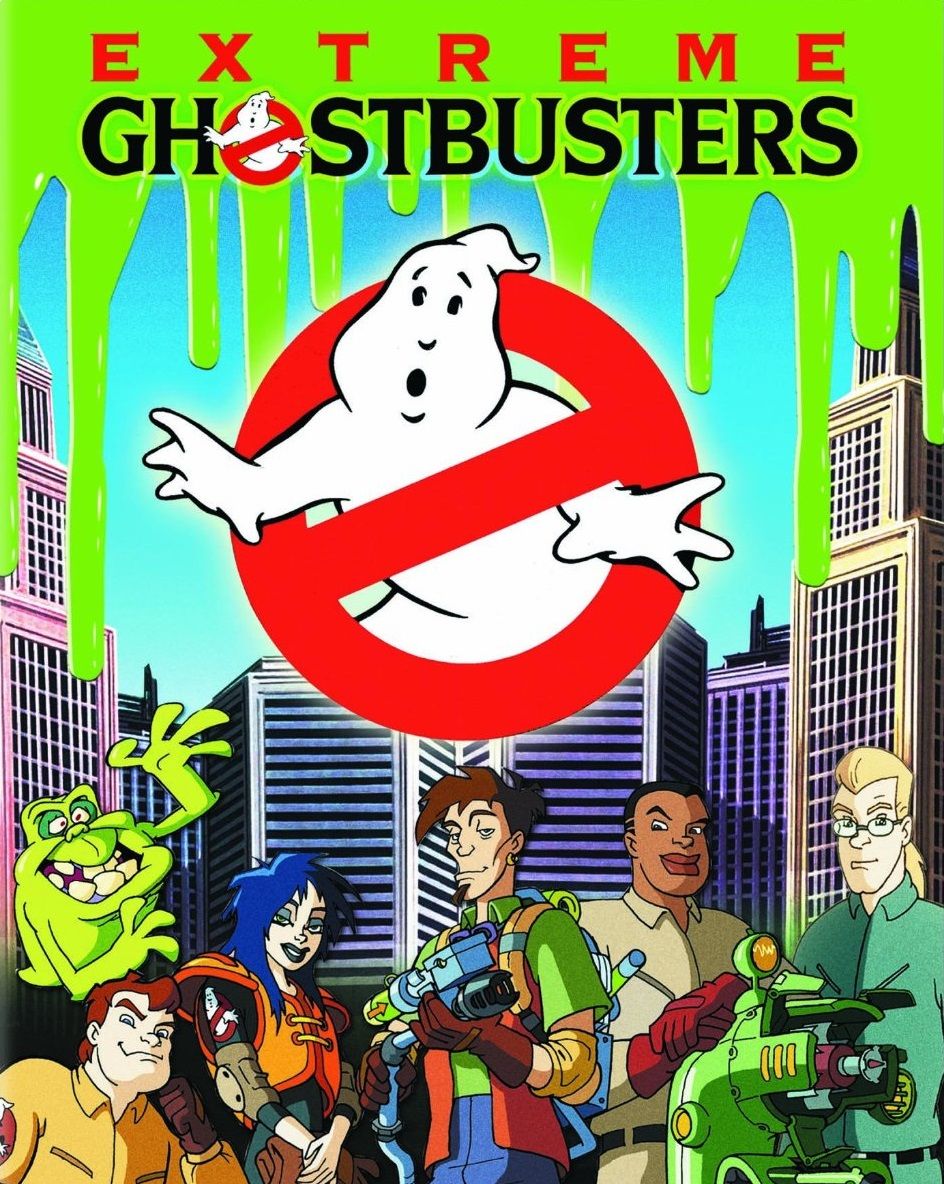
The original Ghostbusters have dissolved and gone their own ways after years of minor supernatural activity. Only Egon Spengler remains at the firehouse, pursuing his mystical and mystic studies. When ghosts begin to reappear, Spengler & his trusty ghost Slimer have to look for new recruits.
They turn to his class and select four students for their various talents: Kylie is a Goth expert, Eduardo is a dependable yet laid-back slacker, Garrett is a paraplegic athlete and Roland is a tech wiz. With Egon’s training and their natural aptitudes, this new team of Extreme Ghostbusters sets out on supernatural journeys to protect New York from ghosts.
The “genuine” Ghostbusters was a beloved television series. It generated a franchise that is still going strong today, and it had a major effect on the horror comedy genre. However, Extreme Ghostbusters excels at dealing with emotion in a way that no previous edition of the franchise has.
This new generation off-shoot has all the aspects of a classic coming-of-age story dialed up to eleven. Over the course of the series, we see the team come into their own. Their skills improve under the tutelage of Egon. They go from being a group of misfits to a close-knit team of dedicated Ghostbusters and really fill the shoes of their predecessors in terms of both action and comedy.
The love-hate relationship between the genius Kylie and the slacker Eduardo, Egon’s disillusionment with his work, the fact that he clings to the Ghostbusters because he has nothing else; all of these emotional beats come across perfectly. Of course, animation plays a large role in that as well. This show is, as many other shows on this list, beautifully illustrated. It embraces the punk-rock aesthetic from the get-go, as Jim Cummings performs a rock version of the classic Ghostbusters intro.
The general tone of this show is dark, gritty & grunge-inspired, employing darker color palettes and sharper caricatures compared to the original series. Billy West’s take on the iconic Slimer is criminally underrated, and Maurice LaMarche does an excellent job of bringing out the pain & sadness that plagues the older Egon Spengler. Overall, Extreme Ghostbusters lives up to its predecessor and then some, bringing a new level of depth to the franchise that hasn’t been seen since.
Jumanji (1996)
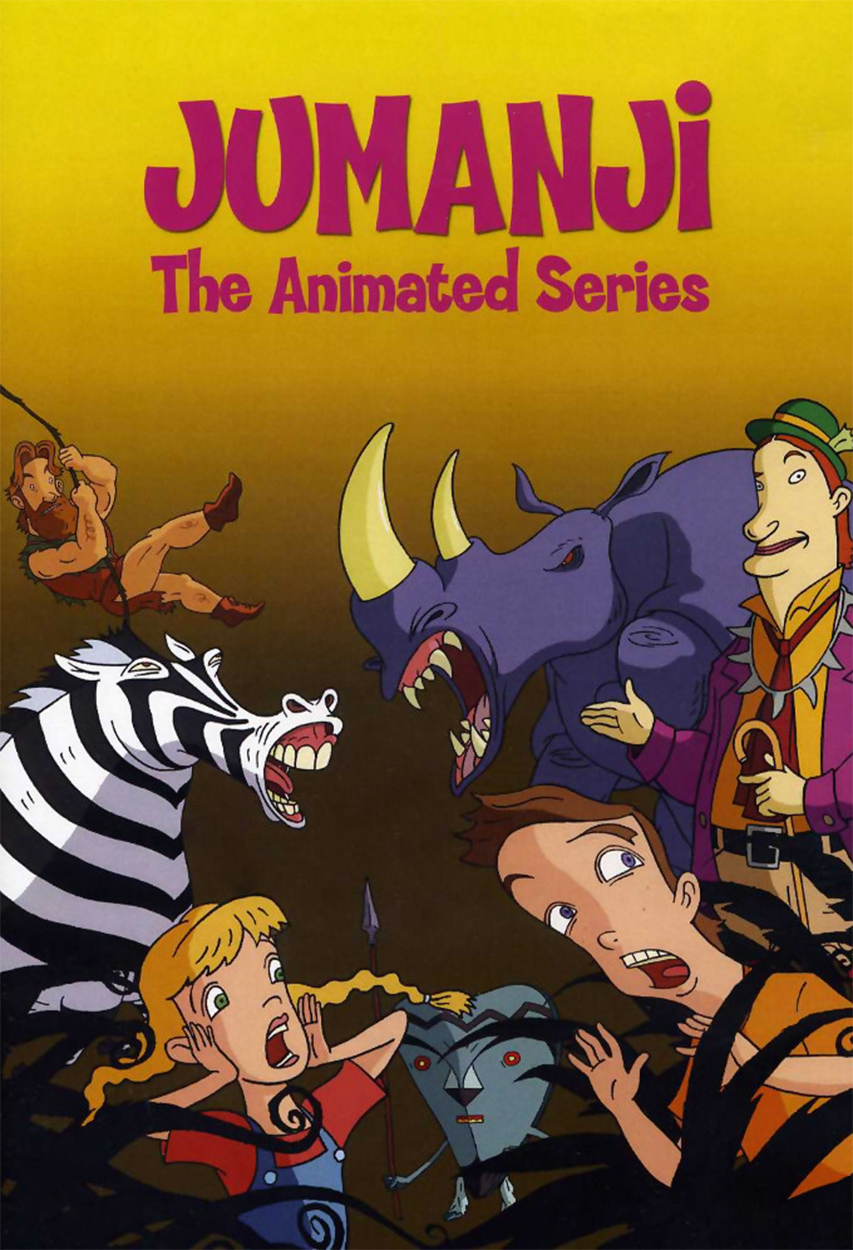
Peter and Judy Shepherd discover a fascinating game called “Jumanji,” which transports them to a parallel universe where they meet Alan Parrish. Alan is ostensibly the deceased son of the town’s ancient shoe factory owner, although he was actually trapped in the game. Now, Peter & Judy must find a way to rescue Alan from the game while solving its riddles and dealing with animals and the notorious hunter Van Pelt.
The show’s animation, as well as how strange it appears, quickly drew our attention. Many exhibitions have helped to popularise ridiculous art. We immediately think of Ed, Edd& Eddy, and Beavis & Butthead. However, Jumanji is a hybrid of the two. The trademark style of illustrator Everett Peck accentuates the brows.
This is evident in his work on Duckman and Squirrel Boy. Alan, Judy & Peter look like Rick, Morty & Summer with longer foreheads and different personalities, and it just works. The show largely follows the plot of the movie, with certain exceptions. For instance, the show’s Jumanji board seems to be conscious!
On multiple occasions, the game randomly sucks in Peter & Judy because they made it “angry”. Another thing that the game highlights is the actual world of Jumanji. We meet a tribe called the Manji: ex-players of Jumanji who gave up hope of returning to the world and created their own culture within the game. Van Pelt is joined by a cast of secondary villains just as good as he is.
And the voice acting in this show is immaculate. Bill Fagerbakke has been the voice of Patrick on Spongebob Squarepants for years now, and he plays Alan Parrish with a similar, feverish aloofness. Sherman Howard, who voiced Lex Luthor in the short-lived cartoon Superboy, has the most iconic iteration of Van Pelt’s catchphrase “Blast!” across the various adaptations of Jumanji.
And Tim Curry’s turn as the villainous “Trader” cements his position as one of the most iconic villains on-screen of all time. At no point in its 40-episode run does Jumanji feel disconnected, and with its stellar cast and eclectic animation style, it makes for a great novelty watch.
Sherlock Holmes in the 22nd Century (1999)
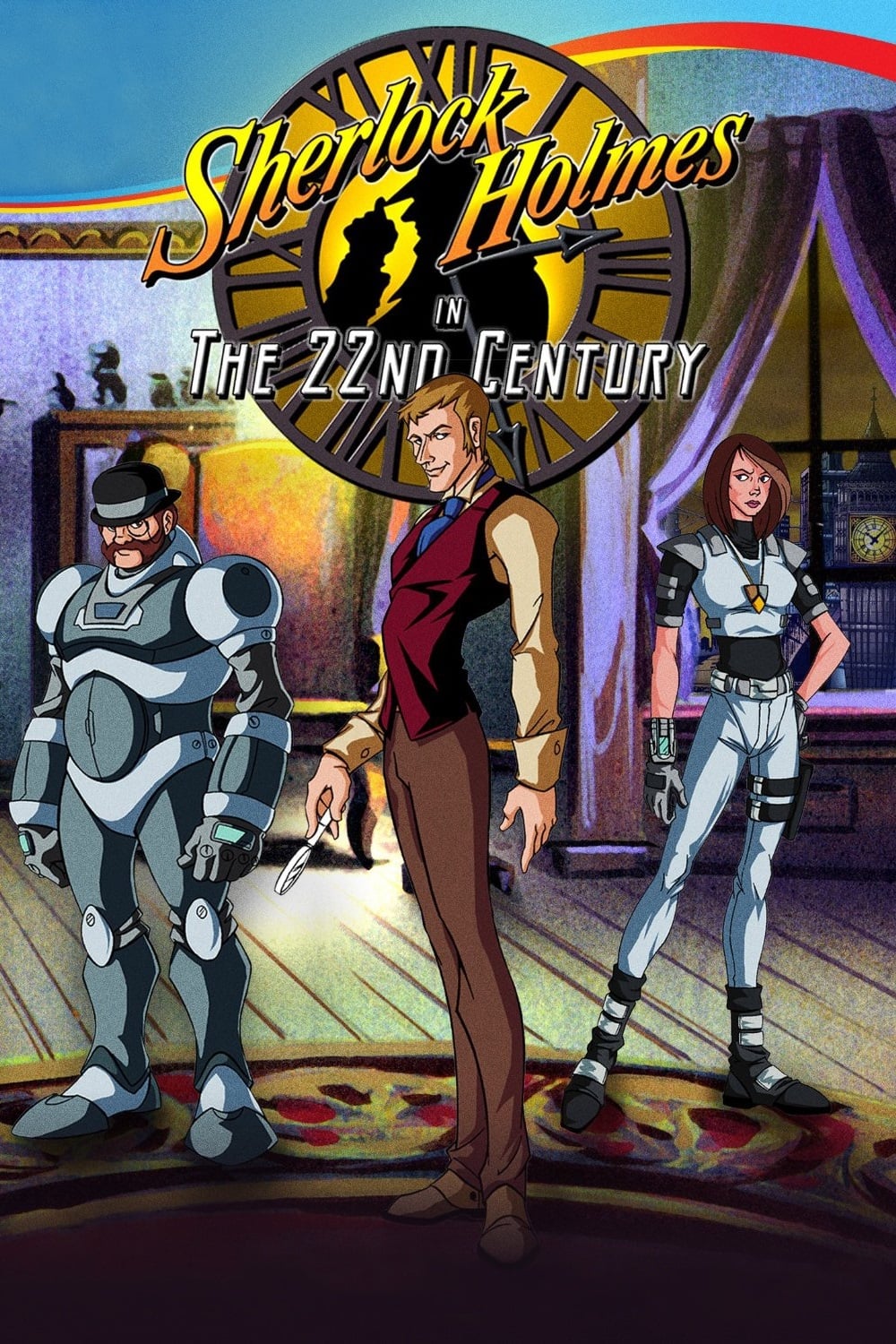
The famous Detective Sherlock Holmes had his final struggle with his arch enemy James Moriarty at the Reichenbach Falls, where they both seemed to die. Inspector Beth Lestrade, a descendant of Inspector G. Lestrade, is following a French mad scientist who appears to be collaborating with Holmes’ old arch adversary hundreds of years later.
Seeing no other choice, Beth decides to “wake up” the great Detective himself! Now in the 22nd century, Sherlock Holmes once again engages his foe in a battle of wits, with his trusty aid Doctor Watson by his side.
The concept of Sherlock Holmes being in the future and facing a scenario that is, for all means and purposes, science fiction enticed us to watch this show. Technology advances at a breakneck pace. The Earth has been turned into a future civilization in the two centuries following Holmes’ “death.”
DIC Entertainment does a great job of portraying this, contrasting the 2D shots of the characters with the borderline 3D shots of modern London, skyscrapers dotting the skyline and aircrafts zipping in and out of frame. However, as the series progresses, we see that the more things change, the more they stay the same. Sure, the world has technology that it never could have imagined in Holmes’ time, a fact that is not lost on him.
But the people remain the same. Their motivations remain consistent. And for Holmes, the game has always been about the puzzle that is the criminal mind. All 26 episodes are adaptations of Arthur Conan Doyle’s works, with the twist of being set in a futuristic setting. For instance, in Episode 3 which adapts The Hound of the Baskervilles, we see the story play out in a similar fashion as to the original novel.
Except for this time, it takes place on the moon, and the “Hound”turns out to be a hologram. In the adaptation of The Mazarin Stone, Holmes must procure the “Mazarin Chip”, a device that can create virtual environments instantly. These episodes follow the general structure of Doyle’s work: in the Baskervilles episode, Holmes deduces Moriarty’s plans for the moon, and in the Mazarin Chip episode, he deceives Moriarty with waxwork that is reminiscent of the origin short story.
The one thing that makes this adaptation gripping is the fact that, even in a sci-fi setting where his Watson is nothing more than a computerised, Holmes’ ability to discern human intention is as sharp as it was in the 19th century. The delightful animation and science-based emulations of Doyle’s original plotlines are an added bonus for us sci-fi nerds.
Double Dragon (1993)
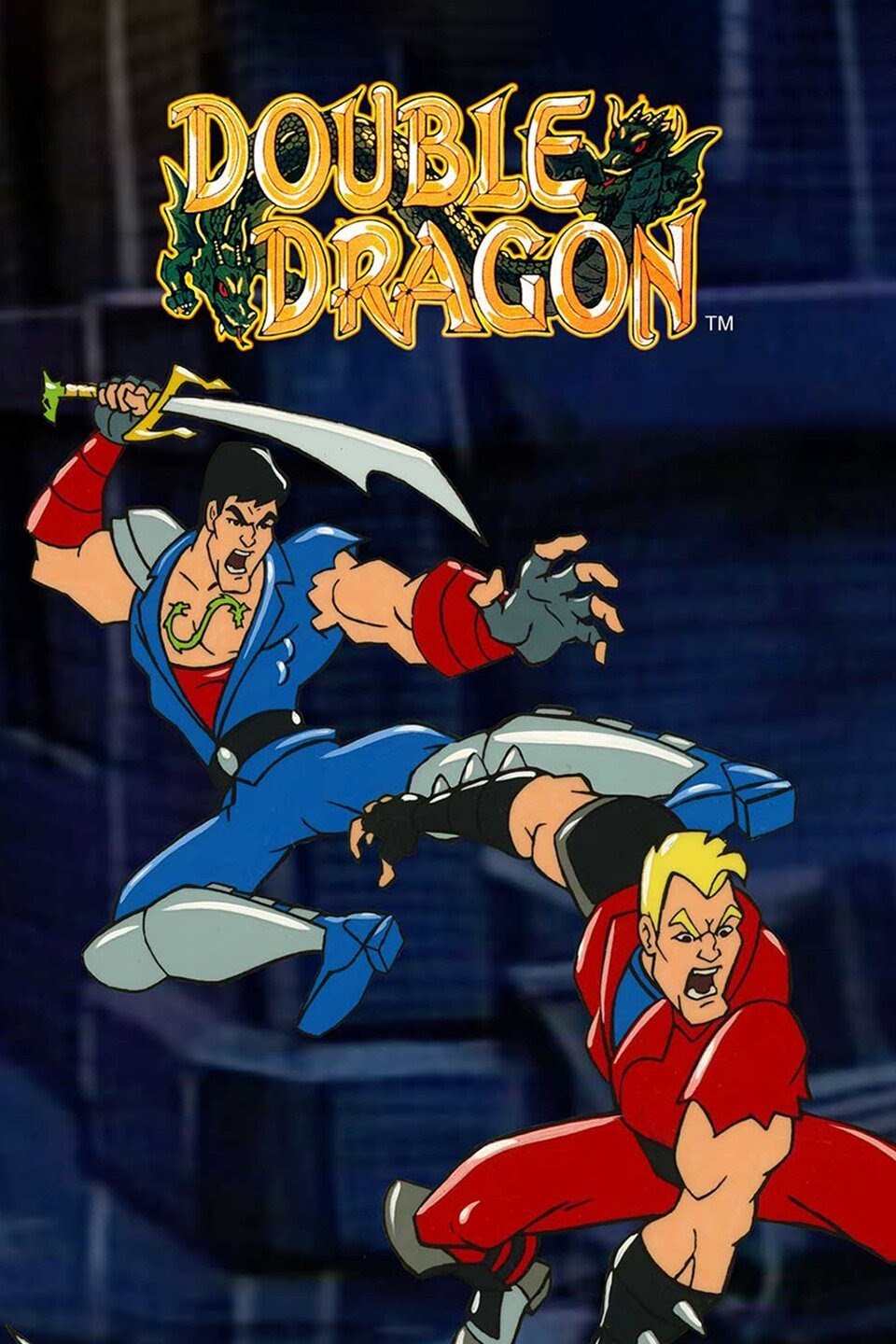
Billy and Jimmy Lee are twins who were separated at birth and are trained in martial arts by two competing styles. The Oldest Dragon, a pacifist who thinks martial arts should be used to defend, is Billy’s mentor.
Jimmy is trained by the Shadow Master, who wants to take over the world with the power of his Black Flame. The brothers reunite after Billy rescues Jimmy from the evil Shadow Master and they wow to fight against his dark forces as the Dragon Masters.
In the 1990s, the martial arts craze that began in the 1970s and was popularized by Bruce Lee’s extreme action films was still going strong. Two months into Double Dragon’s first season, Jackie Chan and Jet Li were breaking into Hollywood, while the famed hip-hop group Wu-Tang Clan released their iconic first album Enter the 36 Chambers.
Michael Donovan and Scott McNeil’s performance as Billy and Jimmy reflects the kind of brotherly love and camaraderie the characters share. The two veteran voice actors capture the very essence of their characters: Billy is the calmer, level-headed twin and Jimmy the fiery, temperamental one.
Donovan’s reserved portrayal contrasts with McNeil’s unhinged performance in delightful harmony. Double Dragon might have been created for kids, but its philosophy is surprisingly nuanced. It follows the belief that though martial arts is a powerful weapon in your arsenal, it is only to be used for the defense of others.
The Oldest Dragon constantly urges the brothers to avoid violence where they can, and they obey his wishes to the best of their abilities. The poetic irony of trying to achieve peace through war is on full display through the show.
Billy & Jimmy’s color-coordinated suits and simultaneous transformation chants are some of the many things that make this show so endearing, and if you’re into the mystical ways of the Shaolin, then Double Dragon is just the kind of show for you to dabble with.
Extreme Dinosaurs (1997)
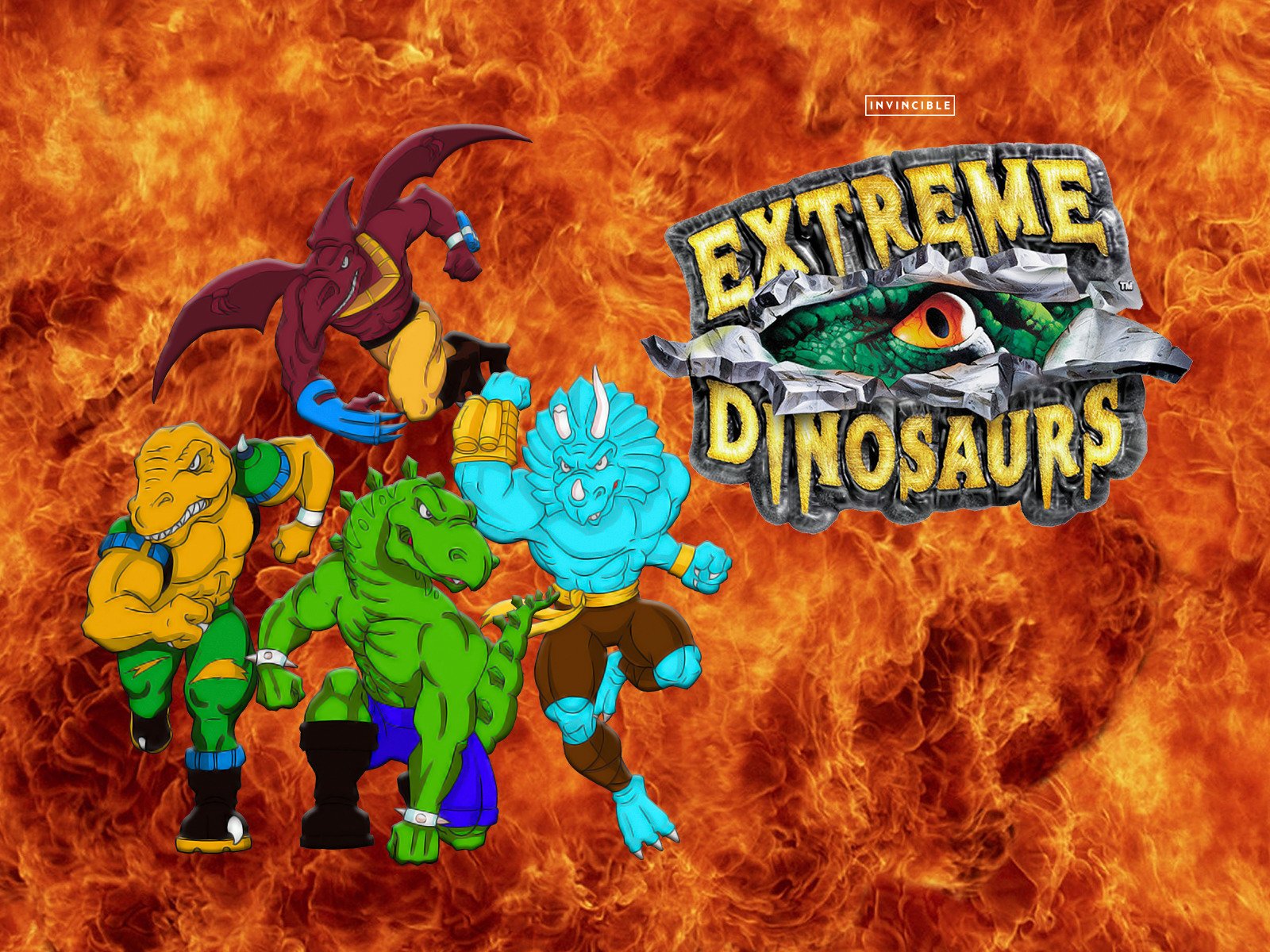
ArgorZardokap, a Quadrainia criminal, arrives on Earth 65 million years ago and turns dinosaurs into human beings. He provides a weapon to the Bad Rap and pits them against the Extreme Dinosaurs.
After getting rid of all the other dinosaurs, the two factions hibernate for 65 million years and wake up in modern-day America. They continue their millennia-old fight, as the Quadrainia continue to meddle with the Extreme Dinosaurs and the Raptors seek to rule the Earth by accelerating global warming so they can live comfortably at last.
These anthropomorphic animals, unlike the other entries on our list, were brought to life on the small screen by a Mattel toy line. Extreme Dinosaurs, in contrast to the Transformers franchise, went unnoticed and was finally terminated.
This is a shame because this show has some of the coolest animation and character designs on our entire list. Scott McNeil proves his prowess as a premier voice actor yet again, lending his voice to T-Bone, the leader of the Extreme Dinosaurs. The overarching themes of Extreme Dinosaurs are well-written as well.
A group of selfish, “bad dinos” that are looking to degrade Earth’s environment for their own comfort is representative of the environmental degradation being caused by coal companies and the fossil fuel industry in general. In fact, throughout the show, the Raptors attempt to accelerate global warming using multiple hokey, yet likely schemes.
For instance, towards the end of the show, Bad Rap attempts to melt all the ice from the North Pole to flood the Earth and raise its temperature. Throughout the show, the Raptors attempt to take hold of devices and technology that will help them accelerate global warming; much like our own relentless exploitation of the fossil fuel industry.
And if you’re not the kind of person who’s motivated by ecological reasons, then watch it for the dinosaurs; we are yet to find a cooler-looking design for half-human half-dinosaur beings and trust us, we’ve been looking.
